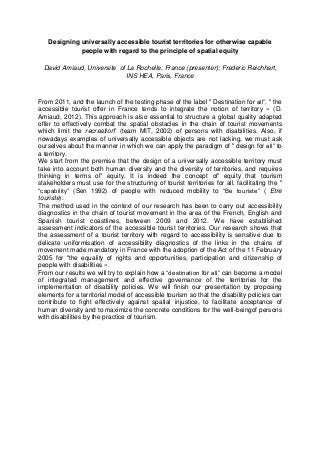
Designing universally accessible tourist territories for otherwise capable people with regard to the principle of spatial equity
- 1. Designing universally accessible tourist territories for otherwise capable people with regard to the principle of spatial equity David Amiaud, Universite of La Rochelle, France (presenter); Frederic Reichhart, INS HEA, Paris, France From 2011, and the launch of the testing phase of the label " Destination for all”, " the accessible tourist offer in France tends to integrate the notion of territory » (D. Amiaud, 2012). This approach is also essential to structure a global quality adapted offer to effectively combat the spatial obstacles in the chain of tourist movements which limit the recreation" (team MIT, 2002) of persons with disabilities. Also, if nowadays examples of universally accessible objects are not lacking, we must ask ourselves about the manner in which we can apply the paradigm of " design for all” to a territory. We start from the premise that the design of a universally accessible territory must take into account both human diversity and the diversity of territories, and requires thinking in terms of' equity. It is indeed the concept of' equity that tourism stakeholders must use for the structuring of tourist territories for all, facilitating the " “capability” (Sen 1992) of people with reduced mobility to “Be touriste” ( Etre touriste). The method used in the context of our research has been to carry out accessibility diagnostics in the chain of tourist movement in the area of the French, English and Spanish tourist coastlines, between 2009 and 2012. We have established assessment indicators of the accessible tourist territories. Our research shows that the assessment of a tourist territory with regard to accessibility is sensitive due to delicate uniformisation of accessibility diagnostics of the links in the chains of movement made mandatory in France with the adoption of the Act of the 11 February 2005 for "the equality of rights and opportunities, participation and citizenship of people with disabilities ». From our results we will try to explain how a “destination for all” can become a model of integrated management and effective governance of the territories for the implementation of disability policies. We will finish our presentation by proposing elements for a territorial model of accessible tourism so that the disability policies can contribute to fight effectively against spatial injustice, to facilitate acceptance of human diversity and to maximize the concrete conditions for the well-beingof persons with disabilities by the practice of tourism.
- 2. Concevoir des territoires touristiques universellement accessibles pour les personnes autrement capables au regard du principe d’équité spatiale David Amiaud, Université de La Rochelle, France (présentateur); Frédéric Reichhart, INS HEA, Paris, France Depuis 2011, et le lancement de la phase test du label « Destination pour tous », « l’offre touristique accessible en France tend à intégrer la notion de territoire » (D. Amiaud, 2012). Cette démarche est d’ailleurs indispensable pour structurer une offre globale adaptée de qualité permettant de lutter efficacement contre les barrières spatiales de la chaîne du déplacement touristique qui limitent la « recréation » (Equipe M.I.T., 2002) des personnes en situation de handicap. Aussi, si de nos jours les exemples d’objets universellement accessibles ne manquent pas, nous devons nous interroger sur la manière d’appliquer le paradigme de la « conception pour tous » » à un territoire ? Nous partons du postulat que concevoir un territoire universellement accessible suppose de tenir compte à la fois de la diversité humaine et de la diversité des territoires, et donc de réfléchir en termes d’équité. Car c’est bien dans la notion d’équité que les acteurs du tourisme doivent puiser pour structurer des territoires touristiques pour tous facilitant la « capabilité » (Sen, 1992) des personnes à mobilité réduite à Être touriste. La méthode employée dans le cadre de nos recherches a consisté à réaliser des diagnostics d’accessibilité de la chaîne du déplacement touristique au sein de mondes touristiques littoraux français, anglais et espagnol entre 2009 et 2012. Pour cela nous avons mise en place des indicateurs d’évaluation des territoires touristiques accessibles. Les résultats de nos recherches montrent que l’évaluation d’un territoire touristique au regard de l’accessibilité est délicate en raison de la délicate mise en cohérence des diagnostics d’accessibilité des maillons de la chaîne du déplacement rendus obligatoire en France avec l’adoption de la loi du 11 février 2005 pour « l’égalité des droits et des chances, la participation et la citoyenneté des personnes handicapées ». A partir des résultats obtenus nous tenterons d’expliquer en quoi une « destination pour tous » peut devenir un modèle de gestion intégrée et de gouvernance des territoires efficace pour la mise en place de politiques du handicap. Et Il s’agira pour finir notre parcours de proposer des éléments pour un modèle territorial du tourisme accessible afin que les politiques du handicap puissent contribuer à lutter efficacement contre les injustices spatiales, à faciliter l’acceptation de la diversité humaine et à maximiser les conditions de concrétisation du bien-être des personnes en situation de handicap par pratique du tourisme.
